Science
(www.olympiadsuccess.com)
Chapter 14: Chemical Effects of Electric Current
Class: VIII
Exemplar Solutions
MULTIPLE CHOICE QUESTIONS
Question 1
An electric current can produce
(a) heating effect only.
(b) chemical effect only.
(c) magnetic effect only.
(d) chemical, heating, and magnetic effects.
Answer 1 (d)
Question 2
Boojho and Paheli performed experiments taking similar bulbs and cells but two different solutions A and B as shown in Fig.14.1
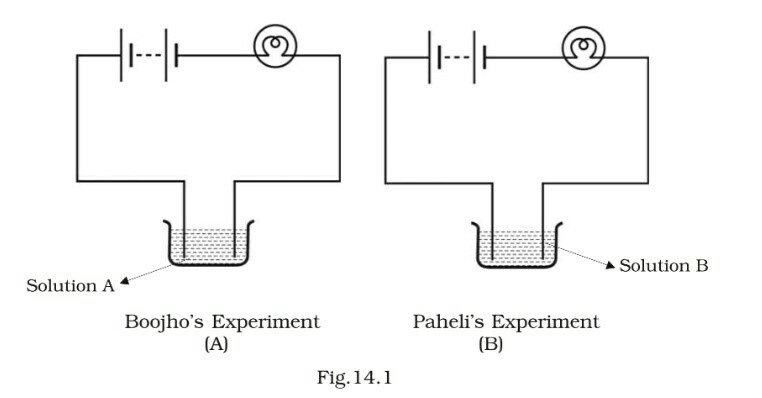
They found that the bulb in the setup A glows more brightly as compared to that of the setup B. You would conclude that
(a) higher current is flowing through the circuit in setup A.
(b) higher current is flowing through the circuit in setup B.
(c) equal current is flowing through both the circuits.
(d) the current flowing through the circuits in the two setups cannot be compared in this manner.
Answer 2 (a)
Question 3
Boojho’s uncle has set up an electroplating factory near his village. He should dispose off the waste of the factory
(a) in the nearby river.
(b) in the nearby pond.
(c) in the nearby cornfield.
(d) according to the disposal guidelines of the local authority.
Answer 3 (d)
Question 4
When electric current is passed through a conducting solution, there is a change of colour of the solution. This indicates
(a) the chemical effect of current.
(b) the heating effect of current.
(c) the magnetic effect of current.
(d) the lightning effect of current.
Answer 4 (a)
Question 5
Which one of the following solutions will not conduct electricity?
(a) lemon juice (c) tap water
(b) vinegar (d) vegetable oil
Answer 5 (d)
Question 6
Which of the following metals is used in electroplating to make objects appear shining?
(a) iron (c) chromium
(b) copper (d) aluminium
Answer 6 (c)
Question 7
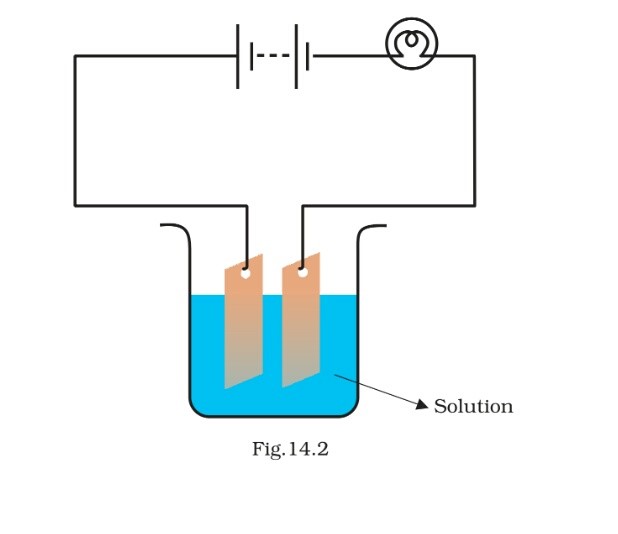
Which of the following solutions will not make the bulb in Fig 14.2 glow?
(a) sodium chlorides
(b) copper sulphate
(c) silver nitrate
(d) sugar solution in diluted water
Answer 7 (d)
VERY SHORT ANSWER QUESTIONS
Question 8
Fill in the blanks
(a) The object to be electroplated is taken as ____________ electrode.
(b) One of the most common applications of chemical effect of electric current is ______________.
(c) Small amount of a mineral salt present naturally in water makes it a______________ of electricity.
(d) Electroplating of ______________ is done on objects like water taps and cycle bell to give them a shiny appearance.
Answer 8
(a) Cathode (c) Conductor
(b) Electroplating (d) Chromium
Question 9
Why is a layer of zinc coated over iron?
Answer 9
A coating of zinc is provided to protect iron from corrosion and rust.
Question 10
Will the solution of sugar in distilled water conduct electricity?
Answer 10
No
Question 11
Name the effect of current responsible for the glow of the bulb in an electric circuit.
Answer 11
Heating effect of electric current.
SHORT ANSWER QUESTIONS
Question 12
Boojho made the circuit given in Fig. 14.3 and observed that the bulb did not glow. On Paheli’s suggestion he added one more cell in the circuit. The bulb now glows. Explain.
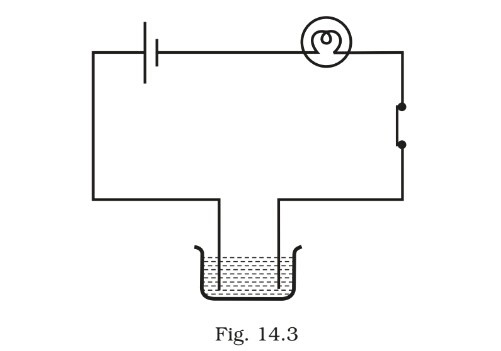
Answer 12
Addition of another cell increased the current through the bulb sufficiently to make it glow.
Question 13
Paheli set up an experiment using liquid A in the beaker as shown in Fig. 14.4. She observed that the bulb glows. Then she replaced the liquid A by another liquid B. This time the bulb did not glow. Boojho suggested replacing the bulb by an LED. They observed that the LED glows. Explain.
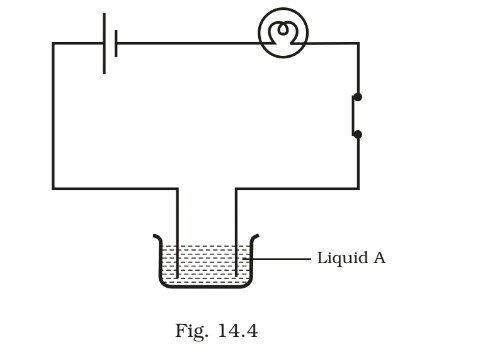
Answer 13
The current through liquid B could be weak and therefore unable to make the bulb glow. However, it was strong enough for the LED to glow.
Question 14
Paheli wants to deposit silver on an iron spoon. She took silver nitrate (AgNO3) solution in a beaker and setup a simple circuit for electroplating. Which terminal of the battery should the spoon be connected to? What material should the other electrode be made of?
Answer 14
The spoon should be connected to the negative terminal of the battery. The other electrode should be made of silver.
Question 15
Why is tin electroplated on iron to make cans used for storing food?
Answer 15
Tin is less reactive than iron. Tin coating prevents food from coming in contact with iron and thus prevents it from getting spoiled.
Question 16
Observe Fig. 14.5.
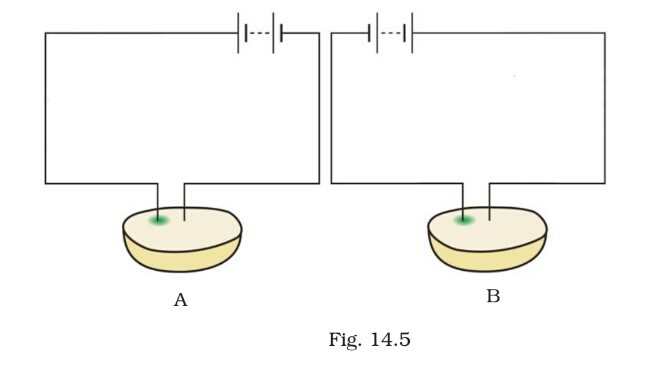
Which of these two circuits A or B shows the correct observation?
Answer 16
Diagram A shows the correct observation.
Question 17
Observe the following circuits carefully. In which circuit will the bulb glow. Write ‘Yes’ or ‘No’ in the blank space provided along each of the circuit given in Fig. 14.6.
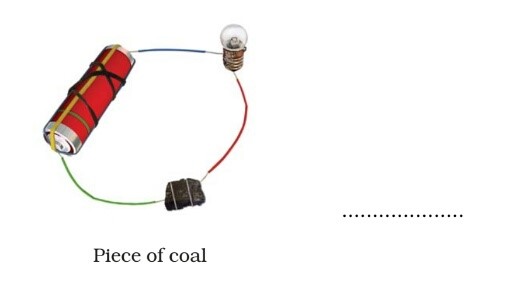
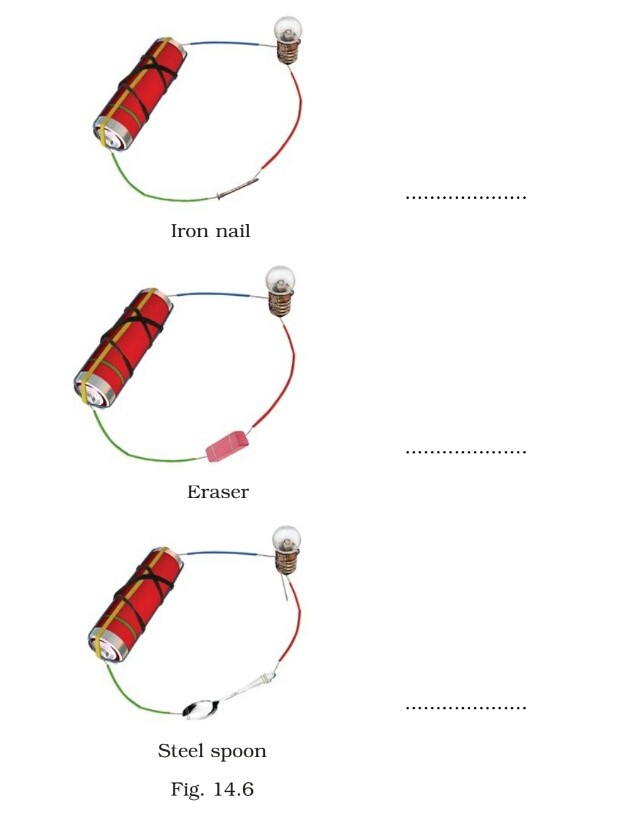
Answer 17
No, Yes, No, Yes
LONG ANSWER QUESTIONS
Question 18
An electric current is passed through a conducting solution. List any three possible observations.
Answer 18
Question 19
In the circuit given as Fig. 14.7, Boojho observed that copper is deposited on the electrode connected to the negative terminal the battery. Paheli tried to repeat the same experiment. But she could find only one copper plate. Therefore she took a carbon rod as negative electrode. Will copper be still deposited on the carbon rod? Explain your answer.
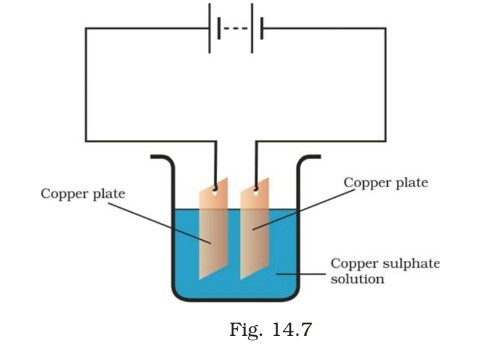
Answer 19
Yes, copper from the copper sulphate solution will be deposited on the carbon rod. Copper from the copper plate will be dissolved into the copper sulphate solution for electroplating.
Question 20
Observe the circuit given in Fig. 14.8
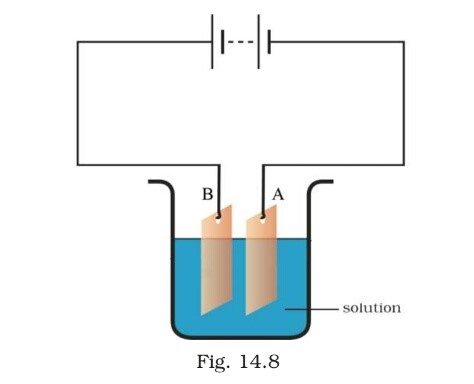
Boojho set up this circuit for purification of copper. What will be the nature of – (i) plate A (ii) plate B (iii) the solution.
Explain the process of purification.
Answer 20
Copper from impure copper plate is transferred to the pure copper plate by the process of electroplating.
Question 21
Observe the following circuit given in Fig. 14.9.
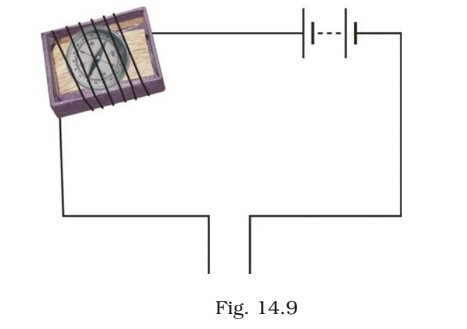
Current does not flow in the circuit if there is a gap between the two wires. Does it indicate that air is a poor conductor of electricity? Does air never conduct electricity? Explain.
Answer 21
Yes, air is a poor conductor of electricity. No, under certain conditions, such as during lightning, air may conduct electricity.
Question 22
Boojho made the circuit shown in Fig. 14.10. He wanted to observe what happens when an electric current is passed through water. But he forgot to add a few drops of lemon juice to water. Will it make any difference to his observations? Explain.
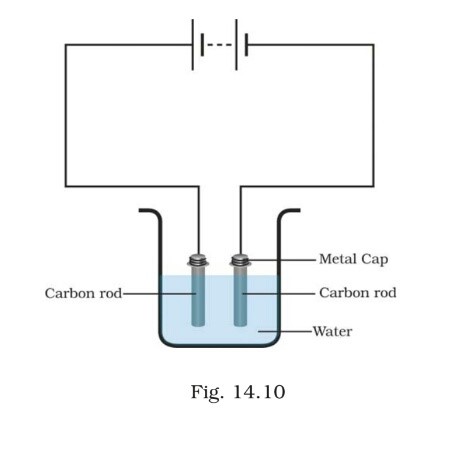
Answer 22
If the water is distilled water and lemon juice is not added, no current will pass through the circuit. If the water taken is salty, then a feeble current will pass through the circuit and bubbles will be seen on the negative electrode.
Question 23
Observing that the bulb does not glow in the circuit shown in Fig. 14.11 A, Boojho changed the circuit as shown in Fig 14.11 B. He observed deflection in the magnetic compass.
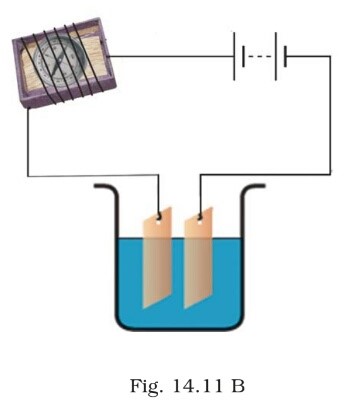
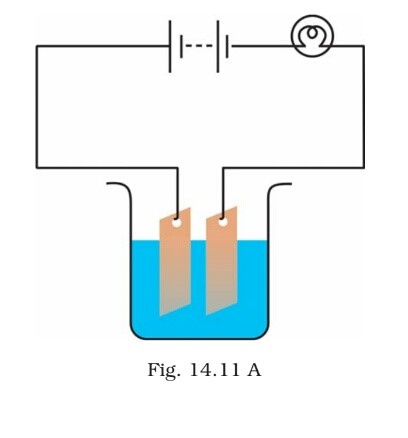
Answer 23
Question 24
You are provided with a magnetic compass, an empty match box, a battery of two cells and connecting wires. Using these objects how will you make a tester for testing an electric circuit? Draw the necessary circuit diagram and explain.
Answer 24
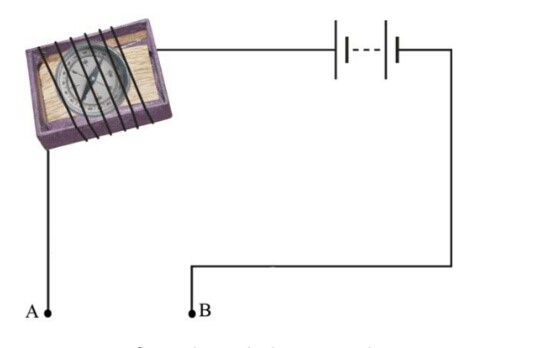
Whenever current flows through the circuit the megnetic compass needle shows deflection due to magnetic effect of current.
Yearlong program for Olympiads preparation & to build necessary skills for future.
Explore More
Time to mark your calendar with the upcoming Olympiads exam schedule.
Explore More
Take your Olympiad preparation to next-level by taking LIVE Classes.
Explore More
Assess your performance by taking topic-wise and full length mock tests.
Explore More
Online tuitions for international compeitions like SASMO, SEAMO, etc for Grades 1-11.
Explore More